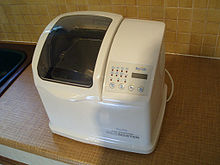Bread maker
A bread maker (also bread maker or bread maker ) is an electrical kitchen appliance that can produce bread semi-automatically . The first vending machine of this type was brought onto the market in 1986 by the Japanese company Matsushita Electric Industrial Co. or Panasonic as Bread Bakery . In Germany the device was sold under the name Der Hausbäcker .
Layout and function
Bread makers mix and knead the filled ingredients independently with the help of one or two kneading hooks to form a dough and run a heating profile (if necessary with resting phases). Parameters such as start time or degree of browning can usually be set on operating elements. Various programs are available, such as for cake, jam or bread.
The shape of the bread is adapted to the container (mostly loaf shape). It contains sealed shafts for the kneading hooks introduced from below, onto which the kneading hooks are attached from the inside. From below, drivers driven by a motor engage in the shaft ends designed as a coupling.
Due to their design, the devices lack the top heat function known from baking ovens , so that crust formation and browning takes place through hot air flowing past the baking container.
Baking machines typically have a toothed belt gear inside with a capacitor motor with a reversal of direction. A heating element (around 800 W) is freely accessible under the removable baking container. The components are controlled with a central microcontroller via relays and a triac switch (for the motor). The microcontroller generates the program times, controls the LCD display and signal ( buzzer ) and evaluates the buttons and a temperature sensor .

